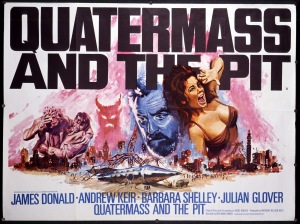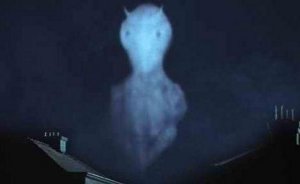
So, I’m watching Quatermass and the Pit, the 1967 Hammer Films remake of the classic 1958-9 television serial written by Nigel Kneale. As you are probably aware, this is not really a historical film, but I think that it’s relevant to the themes of the blog — particularly, I think it demonstrates some of the dangerous archaeology that I have referred to earlier in terms of the work of HP Lovecraft. (If you’re interested in me talking about archaeology in Lovecraft, I might write up my HPL talks as a longer piece one of these days).
Anyway, the story is a familiar one. Excavations for an Underground line reveal skeletons — happens all the time in reality. But these skeletons are a little weird: the press describes them as “underground ape men,” and they have some very unusual skulls. In another neat touch, when a metal object is found along with them, people assume it’s an unexploded bomb — as we’ve recently seen, this isn’t implausible.
(Prophetically, when the bomb squad are examining the metal object, they speculate that it’s a “Satan.”)
Meanwhile, amidst all these reminders of man’s inhumanity to man, Professor Quatermass is being prosed at about the need for military moon bases by the army. He and military rocket expert Breen (sp?) get called in to take a look at the metal object, which, it gradually becomes clear is some kind of spaceship. Simultaneously, it becomes clear that there’s something off about the whole area — people have always been frightened of it.
There’s a lovely, high-tech palaeontology lab in an old building, which is a very British thing and something I’m always happy to see. “We don’t just dig with trowels, you know,” the dude says. Of course, gradually it becomes clear that the object is a spaceship, somehow associated with these skellingtons that are millions of years old. Although the government denies the alien theory, odd things start to happen around the dig site …
I think the most interesting thing to me here is the way in which the story blends the pseudo-science of a Von-Daniken-like ancient alien thing and the traditional horror of a series of haunted-house incidents. In a way, it reminds of the way Ring 2 doubles down on its psychic pseudo-science, only a) obviously this came first, and b) less personal.

I’m not going to recap the film here — I’m sure you can find better summaries and analysis elsewhere. But I did want to touch on the theme of dangerous archaeology a little bit. Here are some of the basic principles in bullet-point form:
- Underground = secret = past = dead = dreams/unconscious
- Archaeologists are portrayed as detectives, but also transgress the above-/under-ground boundary.
- They “bring the past to life” — in education, this is good!
- But in archaeological horror, it’s usually a bit more literal.
In my Lovecraft talk, I suggested that for Lovecraft, history and place are inextricably linked with identity. Historical or archaeological research has the potential to tell you that your history isn’t what you thought it was — which means you aren’t who you thought you were. So the specific brand of archaeological horror in Lovecraft isn’t just like a mummy or a vengeful ghost that comes to life and kills people, it’s a horror that comes from what archaeology actually does, i.e. tells you about your past. It’s just that if you’re a Lovecraft protagonist (or, as he acknowledged, Lovecraft himself) you probably don’t want to hear it. In many Lovecraft stories, learning about your past actually takes you back in time (“The Rats in the Walls”) or brings back creatures from long ago (“At the Mountains of Madness,” “The Shadow Out of Time,” The Case of Charles Dexter Ward), but always with that subtext of there being an unpleasant revelation of your own poisoned heritage. (Some Lovecraft critic used that phrase, but I can’t remember who.)
In a way, the Quatermass story has the same sort of general principle — an archaeological revelation that actually regresses people to a primitive state, enacting genetic memories of a “race purge” and unleashing an urge to kill. But the film is so drenched in Gothic, diabolical imagery that its effect is very different from the poisoned history in Lovecraft — that annihilating, mutating influence. Instead of Lovecraft’s “if your history isn’t what you thought it was, then you aren’t who you thought you were,” it’s a subtly different “if your history isn’t what you told yourself it was, then you are who you were always afraid you were.”
Now, in a way, I think that’s actually closer to what frightens people about what history reveals. Not that our past isn’t what we thought it was, but that it’s exactly what we thought it was, and we’re brutal, stupid, hate-filled monsters, doomed to repeat the same petty, vicious dramas forever and ever. As it happens, I don’t think that’s actually the case — I think (say it with me) it’s more complex than that — but I feel that tug just like everyone else does.
Also, the final shot — the two surviving main characters standing at opposite sides of the screen, unable to talk to or comfort each other, barely even able to look at each other — is pretty baller.
Also, Julian Glover is in everything.